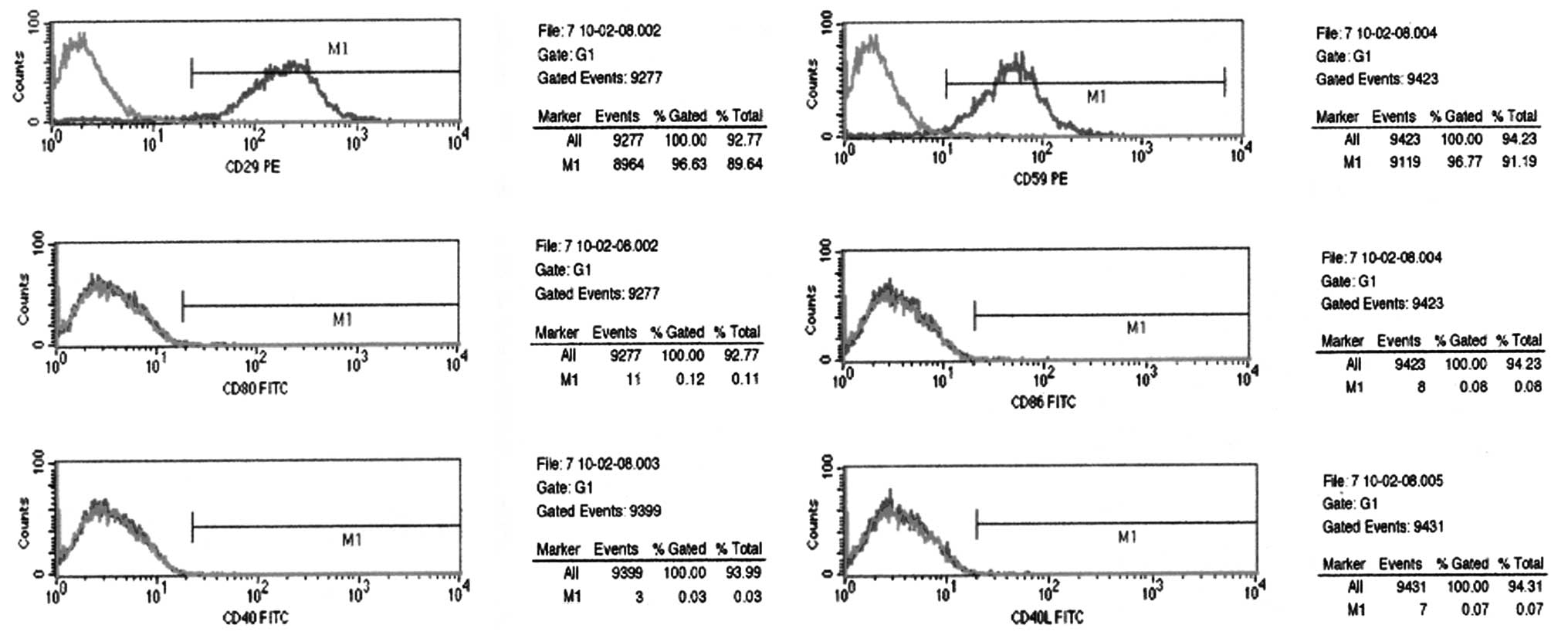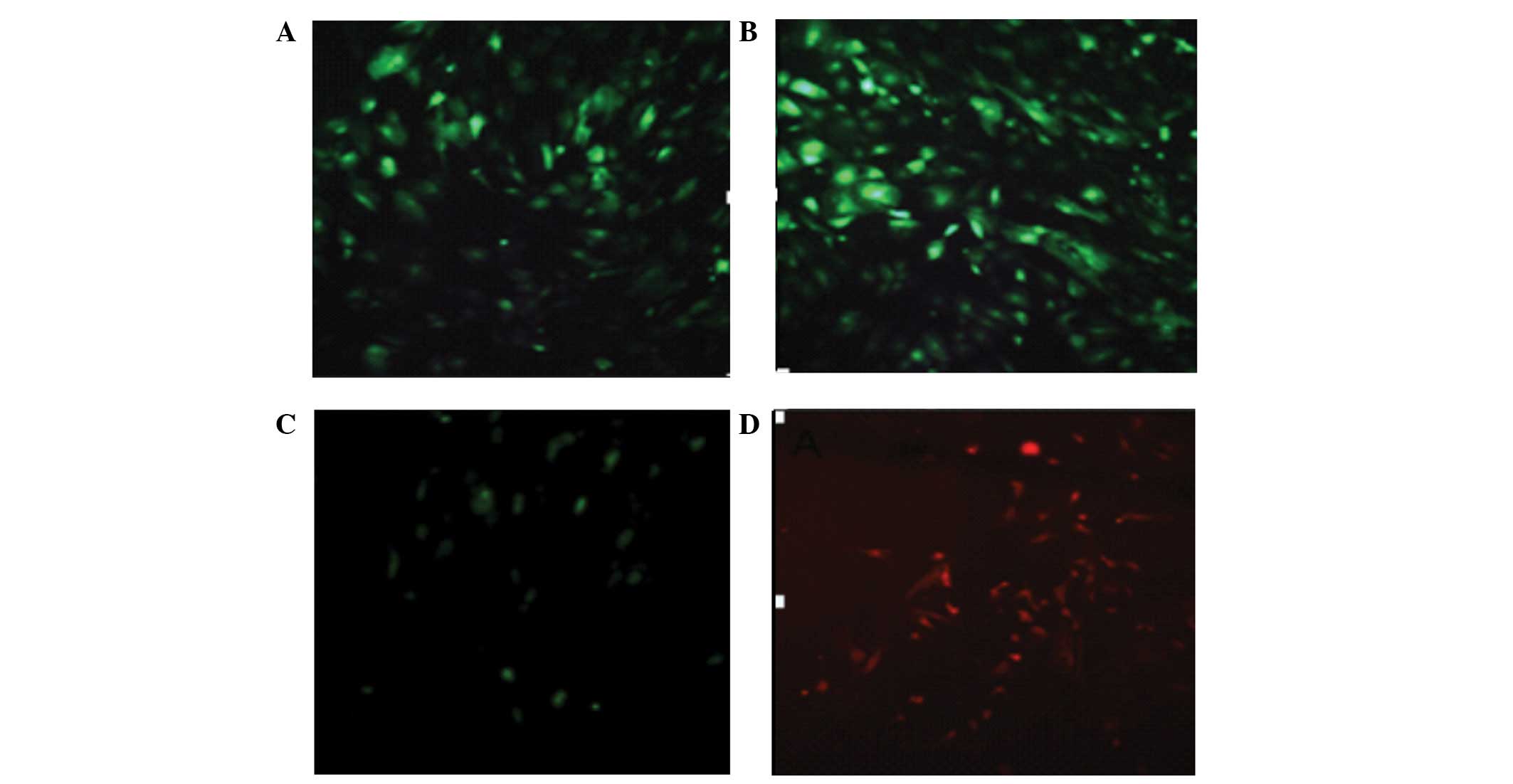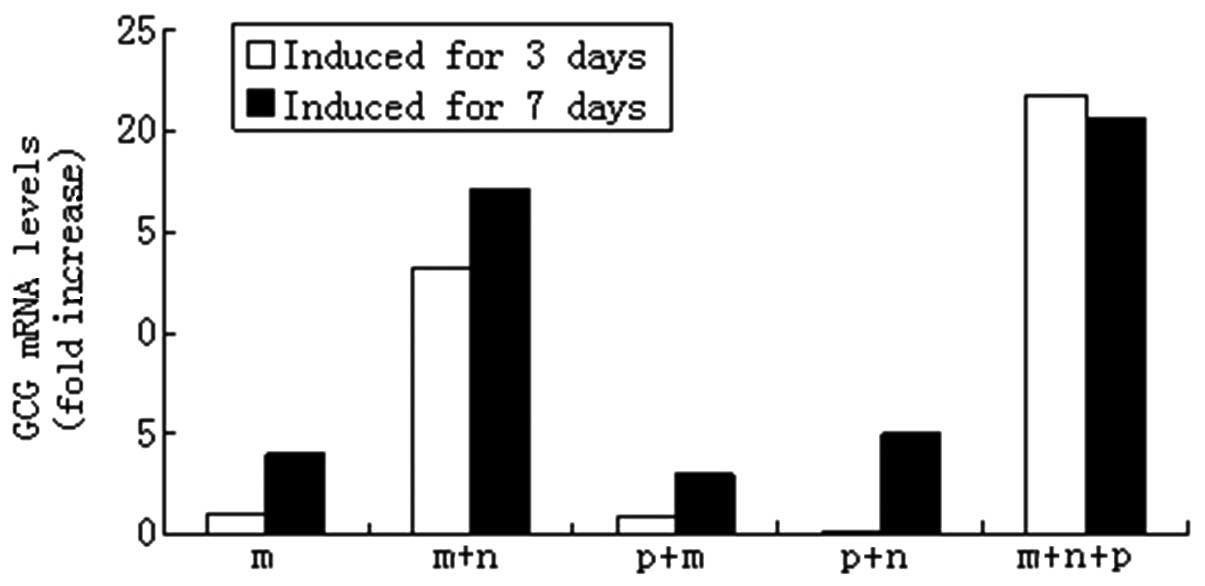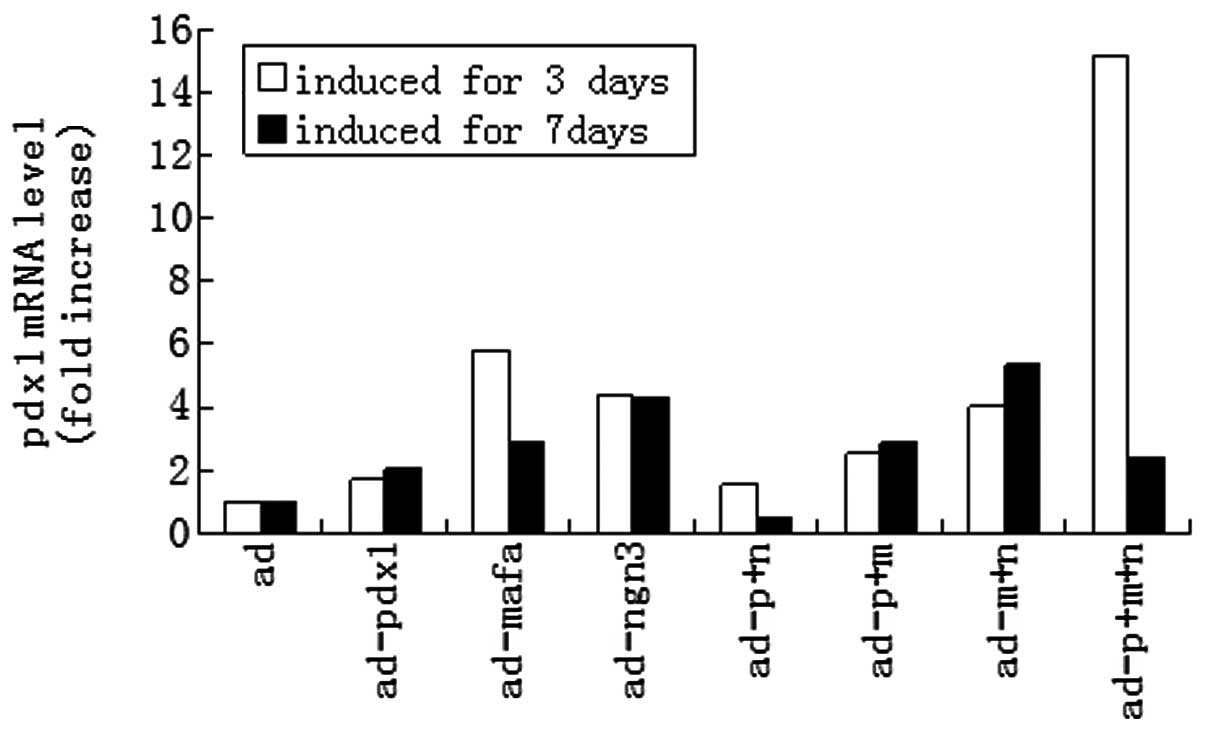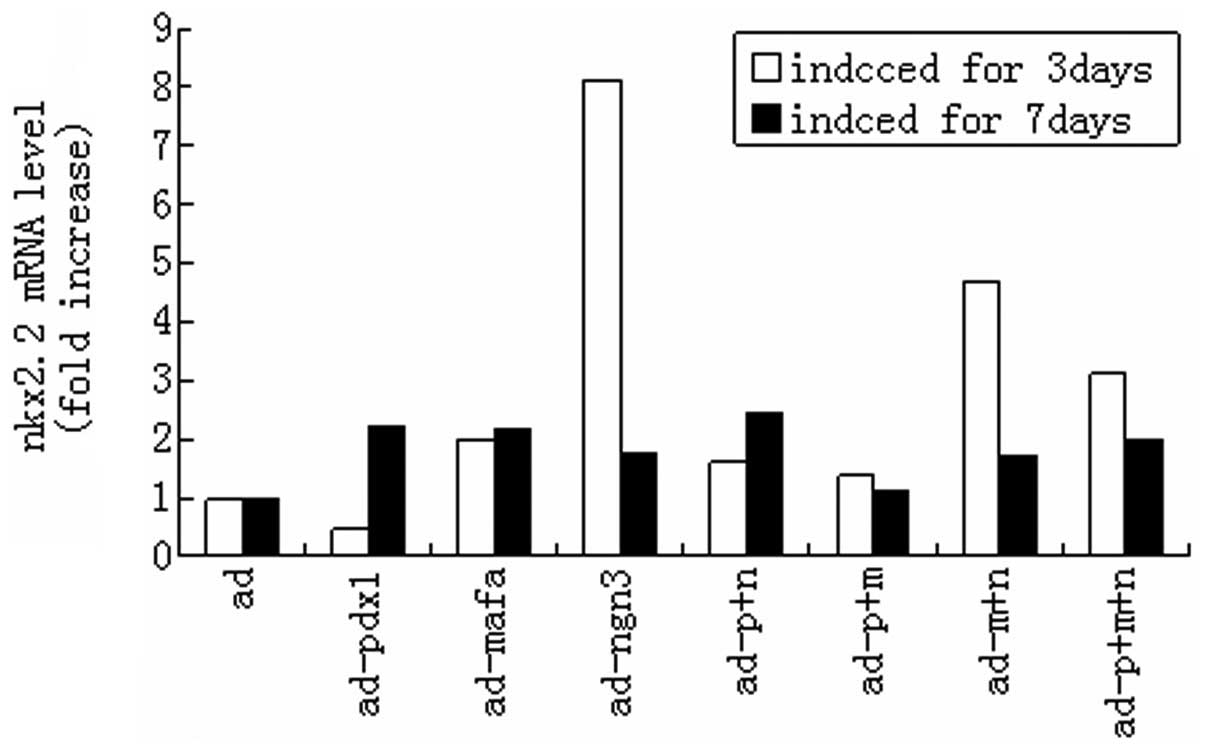Programming of human umbilical cord mesenchymal stem cells in vitro to promote pancreatic gene expression
- Authors:
- Published online on: July 23, 2013 https://doi.org/10.3892/mmr.2013.1598
- Pages: 769-774
Abstract
Introduction
Mesenchymal stem cells (MSCs) are derived from a wide range of sources. Human mesenchymal stem cells isolated from the Wharton’s jelly of the umbilical cord (HUMSCs) are easily obtained (1). These cells display the properties of stem cells and stromal cells, including the expression of matrix receptors [cluster of differentiation 44 (CD44) and CD105], integrins (CD29 and CD51) and stem cell markers [Src homology 2 (SH2) and SH3], and they may be induced to differentiate into a variety of mature cells (2). Unlike MSCs isolated from other sources, such as fetal organs and bone marrow, the generation of HUMSCs is not invasive and does not evoke ethical issues. In addition, HUMSCs demonstrate a high proliferation rate and self-renewal capacity compared with other types of adult stem cells. Therefore, HUMSCs may be a valuable novel source of cells for tissue engineering.
Adenoviral vectors are efficiently produced (3) and are capable of transducing proliferating and quiescent cells, thus greatly enhancing gene expression. As the transgene is not integrated into the chromosome, transduction of genes by adenoviral vectors does not modify the genome of infected cells. Therefore, adenoviral vectors are promising gene delivery vehicles (4–6).
Several studies have demonstrated that the expression of key embryonic transcription factors (TFs) in adult MSCs induced their differentiation into insulin-expressing cells (7,8). The pancreatic and duodenal homeobox 1 (pdx1) is expressed in all pancreatic precursor cells during embryonic development and in β-cells in adults (9). The V-maf musculoaponeurotic fibrosarcoma oncogene homolog A (mafa), a member of the basic leucine zipper family, regulates insulin gene expression through binding to the insulin promoter at the C1-box (10). The class B basic helix-loop-helix factor neurogenin 3 (ngn3) is the master gene controlling endocrine cell fate decisions in uncommitted pluripotent pancreatic progenitor cells (11). Previous studies have demonstrated that pdx1, mafa and ngn3 are important for reprogramming MSCs into insulin-producing cells (12).
In the present study, the exogenous expression of the aforementioned three TFs of mouse origin was observed individually or in combination, to assess the programming of HUMSCs into pancreatic endocrine cells. The results demonstrated that the expression of pdx1, ngn3 and mafa activated the endogenous promoters of glucagon, pdx1 and nkx2.2 in HUMSCs.
Materials and methods
Cell culture
Ethical approval was obtained from the Institutional Review Board of Shantou University Medical College (Shantou, Guangdong, China). The human umbilical cords from consenting patients undergoing full-term cesarean section were collected immediately into sterilized 50 ml tubes, washed with phosphate-buffered saline (PBS) and cut into 2- to 3-cm-long pieces. Following the removal of the arteries and veins, the remaining tissue (the Wharton’s jelly) was sectioned into smaller fragments and transferred to a 75-cm2 flask containing Dulbecco’s modified Eagle’s medium (DMEM)/F12. This culture media was supplemented with 10% fetal bovine serum, 100 μg/ml penicillin/streptomycin, 1 g/ml amphotericin B, 5 ng/ml epidermal growth factor (EGF; Invitrogen Life Technologies, Carlsbad, CA, USA) and 5 ng/ml basic fibroblast growth factor (bFGF, Sigma-Aldrich, St. Louis, MO, USA). The cultures were left undisturbed for 5–7 days in 5% CO2 at 37ºC to allow the migration of cells from the explants, at which point the media were replaced.
Phenotypic characterization of HUMSCs
Approximately 1×106 HUMSCs at passage 3 were dispersed with trypsin and resuspended in PBS containing phycoerythrin (PE)-conjugated antibodies against CD29 and CD59 (BD Biosciences, Franklin Lakes, NJ, USA) for 60 min at 4ºC. Cells were washed three times with PBS and incubated with PE-conjugated rabbit anti-mouse IgG (Santa Cruz Biotechnology, Inc., Santa Cruz, CA, USA) and fluorescein isothiocyanate-conjugated goat anti-rat IgG (Santa Cruz Biotechnology, Inc.), respectively, for 30 min at room temperature. Following three washes, cells were resuspended in 0.5 ml PBS and analyzed by flow cytometry with the use of EPICS XL (Beckman Coulter, Inc., Brea, CA, USA).
Adenoviral expansion and infection
The E1-deleted adenovirus (serotype 5) carrying the cytomegalovirus promoter/enhanced green fluorescent protein (EGFP) hybrid gene was purchased from Vector Gene Technology Company, Ltd. (Beijing, China). Adenoviral vectors expressing mouse pdx1 (Ad-pdx1), mafa (Ad-mafa) and ngn3 (Ad-ngn3) were obtained from the Beta Cell Biology Consortium (Nashville, TN, USA). For amplification of the adenoviruses, 1×108 infectious units of the viruses were added to a 10-cm dish preseeded with 1×106 Ad293 cells (Stratagene, La Jolla, CA, USA) overnight. Following incubation for 30–48 h, cells were harvested by scraping and centrifugation at 12,000 × g for 10 min, while the supernatant was saved for the next round of virus amplification. The harvested cells underwent four freeze/thaw cycles and were spun at 12,000 × g for 10 min to obtain the cell lysates. Serial dilutions of the supernatant and cell lysates were used to transduce the Ad293 cells in a 96-well plate preseeded with 5,000 cells overnight. The viral titers were determined by counting the number of EGFP positive cells under a fluorescence microscope following 30 h of culturing, as described previously (13). HUMSCs at passage 3–5 were seeded at a density of 1×105 cells/well in 6-well plates. Following 24 h of culturing, the media were replaced with 1 ml serum-free media containing the indicated adenoviruses at a multiplicity of infection of 50, for 4 h. The media were then replaced with serum containing media supplemented with 10 ng/ml bFGF, 10 ng/ml EGF and 10 mmol/l nicotinamide. Media were replaced on alternate days over the next seven days.
Quantitative reverse transcription-polymerase chain reaction (qPCR)
Total RNA was isolated from HUMSCs using TRIzol reagent (Invitrogen Life Technologies) according to the manufacturer’s instructions. cDNA was prepared using the Primescript RT Reagent kit (Takara Bio, Inc., Shiga, Japan). cDNA samples were analyzed by qPCR using the SYBR premix (Takara Bio, Inc.) in an ABI 7300 system (Applied Biosystems, Foster City, CA, USA). The primers used for qPCR analyses were as follows: Forward: 5′-ggatgaaatccaccaaagctcac-3′ and reverse: 5′-aagttcaacatcactgccagctc-3′ for mouse pdx1 (NM_008814, 193 bp); forward: 5′-cacattctggagagcgagaag-3′ and reverse: 5′-tctcgtatttctccttgtacaggtc-3′ for mouse mafa (NM_194350, 109 bp); forward: 5′-ttcacgagccagtatgaccttcac-3′, and reverse: 5′-gaagacagacctgggatgcaca-3′ for human pdx1 (NM_000209, 148 bp); forward: 5′-accaaaccgtcccagcgtta-3′ and reverse: 5′-ggctgacaatatcgctactcacaca-3′ for human nkx2.2 (NM_002509, 116 bp); forward: 5′-cagagcttaggacacagagcacatc-3′ and reverse: 5′-acgttgccagctgccttgta-3′ for human glucagon (NM_002054, 161 bp).
Statistical analysis
Data are presented as the mean ± standard deviation of each group. The Student’s t-test was performed using GraphPad Prism 5 (GraphPad Software, Inc., La Jolla, CA, USA). P<0.05 was considered to indicate a statistically significant difference.
Results
Characterization of HUMSCs isolated from the Wharton’s jelly of human umbilical cords
HUMSCs were isolated from human umbilical cords under sterile conditions. These cells grew rapidly in serum containing DMEM media supplemented with bFGF. As shown in Fig. 1A, spindle-shaped HUMSCs migrated out from the fragments of Wharton’s jelly following 5–7 days of culturing. Typically, the primary culture was established within 10–14 days (Fig. 1B), following which, the cells were split every 3–5 days at a ratio of 1:3. The cell shape changed from stellar-like to fibroblastic-like over time.
Phenotypic analysis using flow cytometry was performed on passage 3 HUMSCs. The results showed that HUMSCs expressed surface antigens, CD29 and CD59, which are associated with pluripotent adult stem cells. In addition, the expression levels of CD80, CD86, CD40 and CD40L antigens were low (Fig. 2).
In vitro programming of human umbilical cord mesenchymal stem cells to promote pancreatic gene expression
Fluorescence microscopy demonstrated that adenovirus pdx1, ngn3 and mafa were transfected into HUMSCs (Fig. 3). The morphology of HUMSCs did not change 3 or 7 days following adenovirus transduction. qPCR analysis of the genes associated with the pancreas 3 days after transduction demonstrated that the glucagon gene expression in HUMSCs transfected with ad-EGFP blank, ad-EGFP and ad-ngn3 individually did not result in the expression of the neuroD1 gene (Fig. 4).
qPCR
Numerous TFs including pdx1, ngn3 and mafa have been demonstrated to be essential for the development of β-cells in vivo and the reprogramming of a variety of other cell types into insulin-producing cells in vitro. To demonstrate their potential for generating insulin-producing cells, passage 3–5 HUMSCs were infected with adenoviral vectors carrying mouse pdx1, ngn3 or mafa. Fig. 5 demonstrates that following the exogenous expression of pdx1, ngn3 and mafa individually, only mafa was able to induce glucagon gene expression. The combination of pdx1 and ngn3 had a synergistic effect on the glucagon gene expression and the combination of the three genes demonstrated the greatest effect on glucagon gene expression (P<0.05). At day 7, the combination of mafa and ngn3 resulted in lower expression levels of glucagon than those with mafa transfection alone. However, the combination of the three genes was most effective in inducing the glucagon gene expression at day 7 (P<0.05). To investigate the possible mechanism underlying the activation of the glucagon gene, the expression of endogenous TFs required for pancreatic cell development were measured. Endogenous pdx1 activation was detected upon the expression of any of the three exogenous TFs alone at day 3 and day 7. At day 3, the greatest level of pdx1 gene expression was induced by the combination of the three genes while the combination of any of the two genes induced a lower pdx1 gene expression than that induced by the TFs alone (P<0.05) (Fig. 6). At day 7, the combination of mafa and ngn3 provided the most effective stimulation of the pdx1 gene (P<0.05). Fig. 7 shows that the endogenous pdx1 gene level increased over time. Endogenous nkx2.2 was significantly activated by exogenous expression of ngn3 at day 3 only (P<0.05). In addition, nkx2.2 gene expression was higher at day 7 than at day 3 (P<0.05), with the exception of that when ngn3 alone was transduced (Fig. 7)
Discussion
MSCs have been considered to be candidates for cell replacement therapy, as they may be induced to differentiate into other cell types, such as insulin-producing cells, under certain conditions (14). In this study, it was demonstrated that HUMSCs were able to be programmed into pancreatic endocrine precursors cells by the exogenous expression of three pancreatic TFs, pdx1, ngn3 and mafa.
Previous studies have shown that pluripotent human mesenchymal stem cells may be isolated from Wharton’s jelly of human umbilical cords. These stem cells possess the properties of MSCs and are able to differentiate into neuron-like cells, adipocytes, osteocytes and chondrocytes (2,15). Furthermore, HUMSCs have been observed to express high levels of MSC markers, such as CD29 and CD59, but not graft-versus-host disease-related markers, including CD40, CD40L, CD86 and CD80. Therefore, HUMSCs may be a preferential source for cell replacement therapy for the treatment of various diseases.
In this study, the differentiation potential of HUMSCs into pancreatic lineage cells by exogenous expression of three TFs was investigated. These TFs are important activators of the insulin gene in mature β-cells. Pdx1 is a master regulator for the development of all pancreatic cell types, while ngn3 is critical for the specification of endocrine progenitor cells in the pancreas. Mafa and mafb are effective activators of the insulin and glucagon genes, respectively (16,17).
A primary HUMSC culture in media containing nicotinamide, bFGF and EGF was established. Nicotinamide, a poly (ADP-ribose) synthetase inhibitor, has been demonstrated to stimulate β-cell differentiation in cultured human fetal pancreatic cells (18) and to protect β-cells from desensitization induced by exposure to high glucose levels (19). In addition, EGF is important in the differentiation and proliferation of pdx1-positive pancreatic progenitor cells (20).
In the present study, to investigate the potential mechanism underlying the differentiation of HUMSCs induced by the exogenous TFs, the activation of endogenous glucagon, pdx1 and nkx2.2 genes was examined. Pdx1 expression is maintained throughout the development of the pancreas, providing both spatial and temporal instructions for the commitment of the endoderm to a pancreatic fate. The expression of pdx1 also activates nkx2.2 in α-, β- and pancreatic polypeptide-cells (21). In the current study, it was determined that endogenous glucagon, pdx1 and nkx2.2 were significantly activated by the expression of mouse pdx1, ngn3 and mafa.
The effects of the members of the maf family on insulin and glucagon gene transcription are well understood. Mafa and mafb are effective activators of insulin and glucagon gene transcription, respectively (16,17). Exogenous expression of mouse mafa alone is able to induce glucagon gene expression due to the high homology among family members (22).
Previous studies have demonstrated contradictory results concerning glucagon gene activation by the overexpression of pdx1 and other TFs. Pdx1 was observed to increase glucagon mRNA levels in MSCs derived from the human pancreas and bone marrow, as well as in cultured rat hepatocytes (12,23). However, the results from studies by Ritz-Laser et al(24) and Wang et al(25) identified that glucagon mRNA levels in a glucagonoma cell line and a rat insulinoma cell line were decreased by pdx1 expression. The results of the present study demonstrated that the endogenous glucagon gene was not activated at day 3 when cells were tranduced by pdx1 or ngn3 alone. However, the combination of pdx1 and ngn3 had a synergistic effect on glucagon gene expression, although the expression levels were minimal and increased over time. The combination of the three genes significantly increased the glucagon gene expression levels (by 21-fold) at day 3, which decreased to the basal level at day 7.
Heterologous expression of pdx1 has been observed to induce insulin production in human bone marrow MSCs (8,25). However, the expression levels of insulin were low and the endogenous pdx1 gene was not activated in these studies. In the present study, endogenous pdx1 was activated by the heterologous expression of mouse pdx1, ngn3 and mafa. However, the combination of any two of these genes induced lower expression levels of pdx1 than those induced by the individual genes alone, suggesting there are antagonistic activities between the two genes that affect pdx1 expression when transduced into HUMSCs. At day 3, the combination of all three genes effectively activated pdx1 expression (the levels increased by 15-fold), which decreased by day 7.
In addition, nkx2.2 also induces endocrine differentiation and is controlled by alternative promoters at different cellular stages (26). The results of the present study demonstrated that the expression of the nkx2.2 gene was also significantly increased by ngn3 at day 3. Expression of the Nkx2.2 gene was also significantly increased by Pdx1 at day 7 (Fig. 7).
In conclusion, this study demonstrated that the expression of pdx1, ngn3 and mafa induced a marked change in the gene expression profile of HUMSCs towards an early pancreatic phenotype. The combination of pdx1, ngn3 and mafa activated glucagon and pdx1 in HUMSCs, with the highest expression at day 3. In addition, ngn3 alone induced nkx2.2 expression. Different combinations of the exogenous TFs had either synergistic or antagonistic effects, and the expression of endogenous genes varied with time. This study demonstrated that HUMSCs were induced to express glucagon, the predominant hormone of α-cells. This may suggest that HUMSCs are able to be induced to differentiate into pancreatic endocrine cells.
Acknowledgements
This study was supported by the Science and Technology Planning Project of Guangdong Province, China (grant nos. 2010B031600273, 2008B030301237 and 2006B36005023); the Science and Technology Planning Project of Shantou, China [grant nos. E200900137 and E201100373]; the National Natural Science Foundation of China (grant no. 81070478); and the Foundation of Department of Health, Guangdong, China (grant no. B2010223).
References
|
Weiss ML, Medicetty S, Bledsoe AR, et al: Human umbilical cord matrix stem cells: preliminary characterization and effect of transplantation in a rodent model of Parkinson’s disease. Stem Cells. 24:781–792. 2006.PubMed/NCBI | |
|
Wang HS, Hung SC, Peng ST, et al: Mesenchymal stem cells in the Wharton’s jelly of the human umbilical cord. Stem Cells. 22:1330–1337. 2004. | |
|
Matsushita T, Elliger S, Elliger C, et al: Adeno-associated virus vectors can be efficiently produced without helper virus. Gene Ther. 5:938–945. 1998. View Article : Google Scholar : PubMed/NCBI | |
|
McMahon JM, Conroy S, Lyons M, et al: Gene transfer into rat mesenchymal stem cells: a comparative study of viral and nonviral vectors. Stem Cells Dev. 15:87–96. 2006. View Article : Google Scholar : PubMed/NCBI | |
|
MacKenzie KL, Hackett NR, Crystal RG and Moore MA: Adenoviral vector-mediated gene transfer to primitive human hematopoietic progenitor cells: assessment of transduction and toxicity in long-term culture. Blood. 96:100–108. 2000.PubMed/NCBI | |
|
Brokhman I, Pomp O, Fishman L, et al: Genetic modification of human embryonic stem cells with adenoviral vectors: differences of infectability between lines and correlation of infectability with expression of the coxsackie and adenovirus receptor. Stem Cells Dev. 18:447–456. 2009. View Article : Google Scholar | |
|
Heremans Y, Van De Casteele M, in’t Veld P, et al: Recapitulation of embryonic neuroendocrine differentiation in adult human pancreatic duct cells expressing neurogenin 3. J Cell Biol. 159:303–312. 2002. View Article : Google Scholar | |
|
Karnieli O, Izhar-Prato Y, Bulvik S and Efrat S: Generation of insulin-producing cells from human bone marrow mesenchymal stem cells by genetic manipulation. Stem Cells. 25:2837–2844. 2007. View Article : Google Scholar : PubMed/NCBI | |
|
Soyer J, Flasse L, Raffelsberger W, et al: Rfx6 is an Ngn3-dependent winged helix transcription factor required for pancreatic islet cell development. Development. 137:203–212. 2010. View Article : Google Scholar : PubMed/NCBI | |
|
Zhou Q, Brown J, Kanarek A, et al: In vivo reprogramming of adult pancreatic exocrine cells to beta-cells. Nature. 455:627–632. 2008. View Article : Google Scholar : PubMed/NCBI | |
|
Guz Y, Montminy MR, Stein R, et al: Expression of murine STF-1, a putative insulin gene transcription factor, in beta cells of pancreas, duodenal epithelium and pancreatic exocrine and endocrine progenitors during ontogeny. Development. 121:11–18. 1995. | |
|
Sharma A, Fusco-DeMane D, Henderson E, et al: The role of the insulin control element and RIPE3b1 activators in glucose-stimulated transcription of the insulin gene. Mol Endocrinol. 9:1468–1476. 1995.PubMed/NCBI | |
|
Wilson LM, Wong SH, Yu N, et al: Insulin but not glucagon gene is silenced in human pancreas-derived mesenchymal stem cells. Stem Cells. 27:2703–2711. 2009. View Article : Google Scholar : PubMed/NCBI | |
|
Kawasaki H, Mizuguchi T, Oshima H, et al: Efficient transformation of small hepatocytes into insulin-expressing cells by forced expression of Pdx1. J Hepatobiliary Pancreat Surg. 15:403–409. 2008. View Article : Google Scholar : PubMed/NCBI | |
|
Ma L, Feng XY, Cui BL, et al: Human umbilical cord Wharton’s Jelly-derived mesenchymal stem cells differentiation in to nerve-like cells. Chinese Med J (Engl). 118:1987–1993. 2005. | |
|
Matsuoka TA, Kaneto H, Stein R, et al: MafA regulates expression of genes important to islet beta-cell function. Mol Endocrinol. 21:2764–2774. 2007. View Article : Google Scholar : PubMed/NCBI | |
|
Artner I, Le Lay J, Hang Y, et al: MafB: an activator of the glucagon gene expressed in developing islet alpha- and beta-cells. Diabetes. 55:297–304. 2006. View Article : Google Scholar : PubMed/NCBI | |
|
Otonkoski T, Beattie GM, Mally MI, et al: Nicotinamide is a potent inducer of endocrine differentiation in cultured human fetal pancreatic cells. J Clin Invest. 92:1459–1466. 1993. View Article : Google Scholar : PubMed/NCBI | |
|
Ohgawara H, Kawamura M, Honda M, et al: Reversal of glucose insensitivity of pancreatic B-cells due to prolonged exposure to high glucose in culture: effect of nicotinamide on pancreatic B-cells. Tohoku J Exp Med. 169:159–166. 1993. View Article : Google Scholar : PubMed/NCBI | |
|
Zhang D, Jiang W, Liu M, et al: Highly efficient differentiation of human ES cells and iPS cells into mature pancreatic insulin-producing cells. Cell Res. 19:429–438. 2009. View Article : Google Scholar : PubMed/NCBI | |
|
Sussel L, Kalamaras J, Hartigan-O’Connor DJ, et al: Mice lacking the homeodomain transcription factor Nkx2.2 have diabetes due to arrested differentiation of pancreatic beta cells. Development. 125:2213–2221. 1998.PubMed/NCBI | |
|
Matsuoka TA, Zhao L, Artner I, et al: Members of the large Maf transcription family regulate insulin gene transcription in islet beta cells. Mol Cell Biol. 23:6049–6062. 2003. View Article : Google Scholar : PubMed/NCBI | |
|
Weiss ML, Anderson C, Medicetty S, et al: Immune properties of human umbilical cord Wharton’s jelly-derived cells. Stem Cells. 26:2865–2874. 2008. | |
|
Ritz-Laser B, Gauthier BR, Estreicher A, et al: Ectopic expression of the beta-cell specific transcription factor Pdx1 inhibits glucagon gene transcription. Diabetologia. 46:810–821. 2003. View Article : Google Scholar : PubMed/NCBI | |
|
Wang H, Maechler P, Ritz-Laser B, et al: Pdx1 level defines pancreatic gene expression pattern and cell lineage differentiation. J Biol Chem. 276:25279–25286. 2001. View Article : Google Scholar : PubMed/NCBI | |
|
Watada H, Scheel DW, Leung J and German MS: Distinct gene expression programs function in progenitor and mature islet cells. J Biol Chem. 278:17130–17140. 2003. View Article : Google Scholar : PubMed/NCBI |




